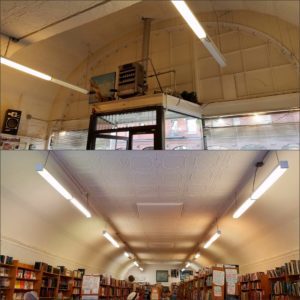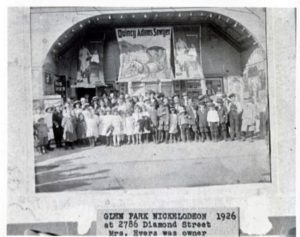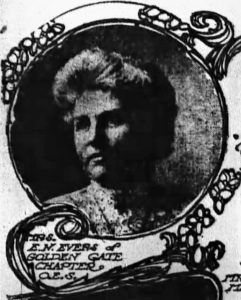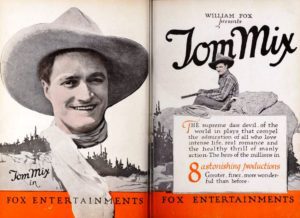Over the past several years, we have uncovered many impressive histories connected with Glen Park. One not yet discussed is the Glen Park connection to the glamor and glitz of Hollywood that began during the earliest days of Tinseltown. This post is Part 1.
…
“Moving pictures” were all the rage during the opening years of the 20th century. The first nickelodeon – literally, a “5 cent theater” – opened in Pittsburgh, Pennsylvania in 1905. By 1913, San Francisco was sporting nearly 100 of the little entertainment houses across town. With a capacity of 100 to 200 people and well known for their uncomfortable wooden chairs, patrons paid a shield, Liberty Head, or buffalo nickel to view silent serial reels such as The Perils of Pauline or The Exploits of Elaine. An accompanying pianist or organist playing live in the theater lent to the drama and excitement, helping patrons become immersed in the action.
Few examples of San Francisco’s nickelodeons remain. One is the former site of Aardvark Books on Church Street near Market that closed for good in 2019. The structure first opened as the Bijou Theatre 1908 and could hold 260 patrons. It was later renamed the Electric Theatre about 1913. Any Aardvark patron who happened to glance above the shelves may have noticed the arched, embossed, Quonset hut-style metal ceiling. At the front of the store were the remains of a series of sockets for flashing incandescent light bulbs that enticed moviegoers, though the windowpanes in front of the sockets had long ago been painted over.

Thanks to one of our resident woman suffragists, the first nickelodeon in Glen Park opened in 1913. Originally named The Glenodeon and later renamed The Diamond Theatre, it appears to have been of similar design as the former Electric Theatre on Church Street. Located about 115 feet north of Chenery at 2774 Diamond Street (later renumbered to 2780 Diamond), the building is no longer standing. That a woman was proprietor may have been unusual for San Francisco but with the history of women’s activism in Glen Park, certainly not out of the ordinary.

The proprietor, Caroline (Mrs. Edward N.) Evers (née Salyard), was born in 1863 in Hespeler, Ontario, Canada to natives of Germany and France. In 1881, Caroline married fellow Ontarian Edward Napoleon Evers and the following year the couple moved to Buffalo, New York. By 1904, they were residing in San Francisco, first on 14th Street in the Duboce Triangle, then in 1906 on Fillmore Street near Geary Street.

Edward was employed as a linotype operator at the Hicks-Judd Company, printer of the San Francisco Block Books. By December 1906 he and his wife were living in Glen Park on Glen Avenue (today Chenery Street between Diamond and Elk Streets) near Lippard Avenue, having purchased a lot from Anna Roller in the Joost Addition to the Glen Park Subdivision (Roller was the daughter of Behrend Joost, developer of Sunnyside). In 1909, they purchased a second lot in the Joost Addition and by 1910, had relocated to Chenery at Chilton Avenue.
In February 1908, Caroline Evers became the first president of the Glen Park Outdoor Art League. Founded by Glen Park resident Johanna Pinther, a co-leader of America’s first suffrage march, the Glen Park Outdoor Art League was a woman’s club that enabled members to pursue civic activities in preparation for a California woman’s suffrage victory. Evers also served as the Worthy Matron (presiding officer) of the Order of the Eastern Star, Golden Gate Chapter, which offered opportunities for women to participate in the Order of Freemasonry. At that time, there were 18 chapters in San Francisco with more than 2,500 members.
While a record of who purchased the lot of the future Glenodeon has yet to be found, the Evers may have constructed the little theater themselves. We can only imagine the excitement and awe of Glen Park residents who watched pictures “move” for the first time. Moreover, among Johanna Pinther’s many skills was piano teaching and we are left to wonder if she may have served as the theater’s first musical accompanist during its earliest years of operation.
In addition to showing serial reels, the Glenodeon was also a place for political meetings. The Glen Park Outdoor Art League held several meetings there, and in 1915 a public meeting attended by Mayor James “Sunny Jim” Rolph and City Engineer Michael M. O’Shaughnessy was held in support of a bond to purchase the Spring Valley Water Company for use in the Hetch Hetchy System. Other candidate meetings were held at the theater, including during the re-election campaign for Mayor Rolph that reportedly attracted an overflow crowd.
Perhaps to modernize the entertainment facility, and with Edward N. Evers having received a permit for additions to the theater, Caroline changed the name to the Diamond Theatre in 1917. As a theater owner, she was an active member of the male-dominated Northern California Division of Motion Picture Owners of America. At annual meetings held in San Francisco, she served on the Organizing and Credentialing Committees, and in 1920 personally welcomed cowboy star Tom Mix to the city.

The final directory listing for the Diamond Theatre was in 1925. Then in 1926, the Evers purchased land in the San Augustine Rancho on the San Jose to Santa Cruz Road (along today’s Highway 17 at Scott’s Valley). There they established Camp Evers, a major stop for automobilists needing gas or a general store. They also offered camping and picnicking for visitors to nearby Big Basin State Park at Felton, California’s oldest state park. The earliest known commercial venture in that area, Camp Evers was also a popular spot for Saturday night dances. The Evers ran the highly popular destination for 20 years until well into their 80s. Caroline Evers died in Santa Cruz in 1950 at the age of 87.
In Part 2, what happened to the Diamond Theatre?
Evelyn Rose, Director and Founder of the Glen Park Neighborhoods History Project, is documenting the histories of Glen Park and nearby neighborhoods. To learn more about our local histories, visit www.GlenParkHistory.org. The Glen Park Neighborhoods History Project is currently offering intermittent virtual programs during the ongoing health crisis. Join the mailing list: GlenParkHistory@gmail.com. The Glen Park Neighborhoods History Project is fiscally sponsored by Independent Arts & Media, a California non-profit corporation. Evelyn is also the author of the history website, Tramps of San Francisco.